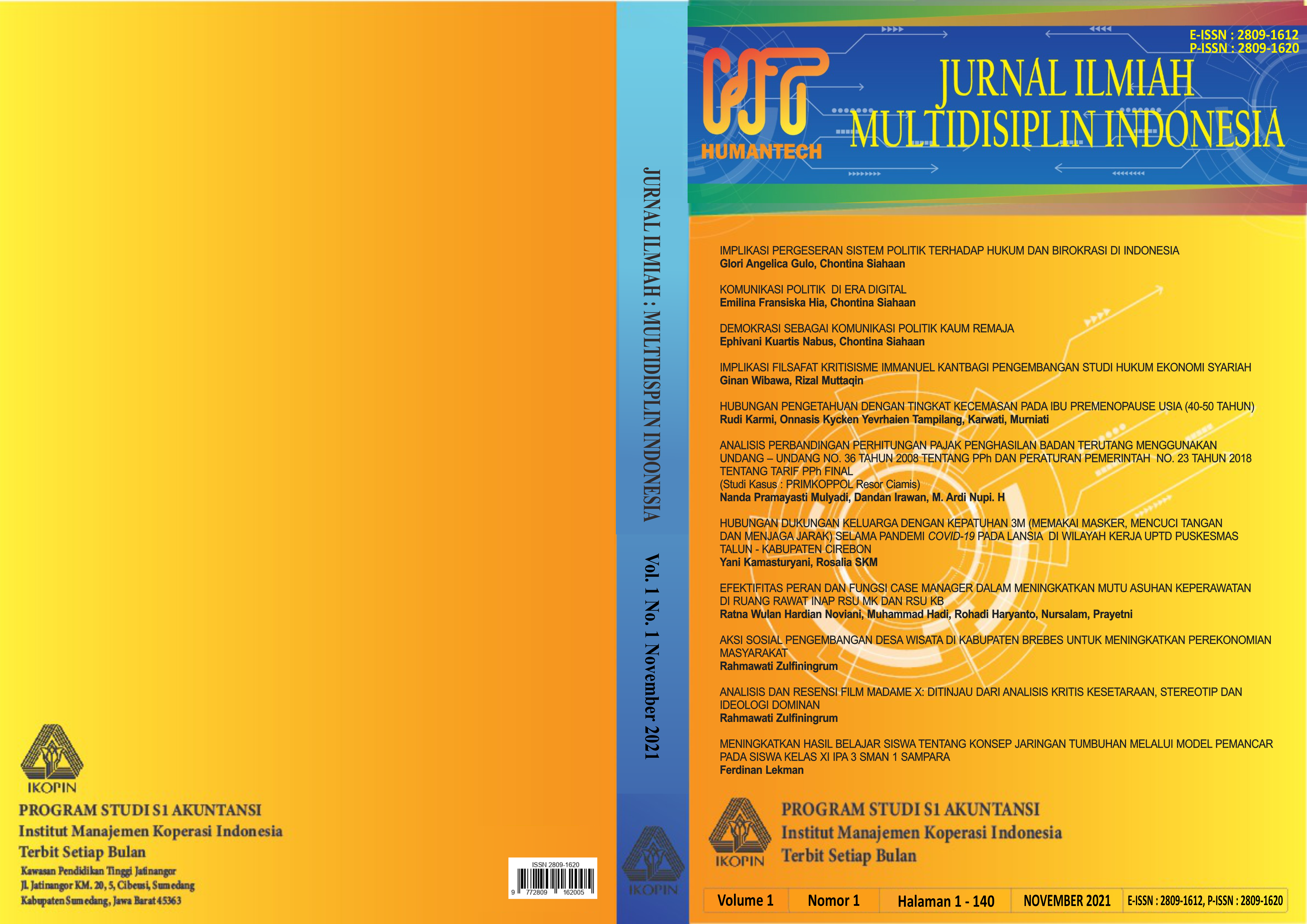KOMUNIKASI POLITIK DI ERA DIGITAL
Main Article Content
Abstract
Selama dua dekade terakhir, Internet telah mempengaruhi aspek kehidupan
manusia, termasuk demokrasi. Dalam konteks Indonesia, fenomena baru yang
dikenal dengan komunikasi politik online telah muncul sejak munculnya
internet pada tahun 1990-an. Ini telah mengubah secara dramatis praktik
komunikasi politik tradisional yang telah diturunkan melalui media
tradisional. Artikel ini berusaha memberikan diskusi praktis dan teoritis
tentang masalah ini. Sebuah studi teoretis tentang bagaimana Internet telah
mengubah teori komunikasi politik klasik. Bagaimana sifat baru Internet
dapat mempengaruhi kualitas dan kuantitas komunikasi politik dan
menimbulkan pertanyaan yang meragukan dalam prosesnya? Apalagi
perdebatan ini dengan mudah sampai pada kesimpulan bahwa komunikasi
politik tidak boleh lepas dari media baru ini di masa depan. Ini mungkin
"laboratorium langsung" yang paling menarik bagi para peneliti tentang
peran potensial Internet dalam proses komunikasi politik.
Article Details
References
Agus Sudibyo & Nezar Patria. The Television Industry in Post-authoritarian Indonesia,
Journal of Contemporary Asia, 43:2, 257-275, 2013. DOI:
1080/00472336.2012.757434
APJII & Puskakom UI. Profil Pengguna Internet Indonesia. Jakarta: Puskakom
UI&APJII, 2016. Castells, Manuel. (2009). Communication Power. New York:
Oxford University
Press.Dijk, Jan A.G.M. Digital Democracy: Vision and Reality dalam I. Snellen & W.
van de Donk ‘Public Administration in the Information Age: Revisited’, IOSPress, 2013.
Dahlberg & Siapera. Radical Democracy and the Internet Interrogating Theory and
Practice. New York: Palgrave Macmillan, 2007.
Druzin & Jessica Li. The Power of The Key Stroke: Is Social Media theRadical
Democratizing Force We Have Been Led to Believe It Is?Harvard Human Right
Journal, February (2015).
Edge, Thomas. Conservatives, White Voters, and the Election of BarackObama. Journal
of Black Studies. Volume 40 Number 3 January 2010426-444
Grömping, Max. (2014). Echo Chambers’ Partisan Facebook Groups during the 2014
Thai Election. Asia Pacific Media Educator. SAGE Publications Los Angeles,
London, New Delhi, Singapore, Washington DC DOI:
1177/1326365X14539185 http://ame.sagepub.com
Hasfi, Nurul. Primordialism through Hoax and Fake News during the 2014 Presidential
Election of Indonesia. Presented at ICISPE International Conference. 2017a
Hasfi, Nurul. Politik Keshalehan Personal dalam Pemilihan Presiden 2014 dalam Media
Sosial Twitter Jurnal Pemikiran Sosiologi Volume 4 No.2 Agustus, 2017b.
Habermas, J. Political Communication in Media Society: Does Democracy Still Enjoy
angnovis 10.1 – Fall 2009 Epistemic Dimension? The Impact of Normative
Theory on Empirical Research. Communication Theory, 16(4), 411-426. 2006.
doi: 10.1111/j.1468-2885.2006.00280.x.
Hill, David T & Krisna Sen.(2005). The Internet in Indonesia's new democracy. Oxon,
England: RoutledgeCurzon
Holmes, David. Communication Theory: Media, Technology and Society. London:
Sage Publication, 2005
Karlsen, Rune. Followers are opinion leaders: The role of people in the flow of political
communication on and beyond social networking Sites. European Journal of
Communication 1 –18.2015. DOI: 10.1177/0267323115577305
Khamis, Sahar. “Cyberactivism” in the Arab Spring: What Social MediaCan and Can
Not Do. International Affairs Forum. Vol 4, Issue 1, (2013).
Laswell, H.H. Propaganda Techniques in the World War. New York: Knopf, 1927.
Lilleker, Darren G. Key Concepts in Political Communication. Sage Publication:
London, Thousand Oak, New Delhi, 2016.
Lim, Merlyna. The Internet, Social Network and Reform in Indonesia. Di N. Couldry
and J. Curran. Contesting Media Power: Alternative Media in A Networked
World. Rowan & Littlefield. 2013
Lim, Merlyna. @crossroads: Democratization & Corporatization of Media in Indonesia.
USA: Perticipatory Media Lab & Ford Foundation, 2011
McNair, Brian. An Introduction to Political Communication. London & New York:
Routledge, 1995.
Nugroho, Yanuar, dkk. Mapping The Lanscape of The Media Industry in Contemporary
Indonesia. Jakarta: Centre for Innovation Policy and Governance, 2012.
O’Reilly T. (2005). What is Web 2.0 : Design patterns and business models for the next
generation of software. Available at:
http://oreilly.com/web2/archive/what-is-web20.html
Tsagarousianou, R. Electronic democracy: Rhetoric and reality. Communications: The
European Journal of Communication Research, 24 (2). (1999). pp. 189–208.
Vedel, Thierry. Political Communication in New Era: Political Communication in The
Edge of Internet (Chapter 3). London & New York: Routledge, 2003.
Zheng, Yongnian & Guoguang wu. Information Technology, Public Space, and
Collective Action in China. Comparative Political Studies, vol. 38 no. 5, june
507-536

